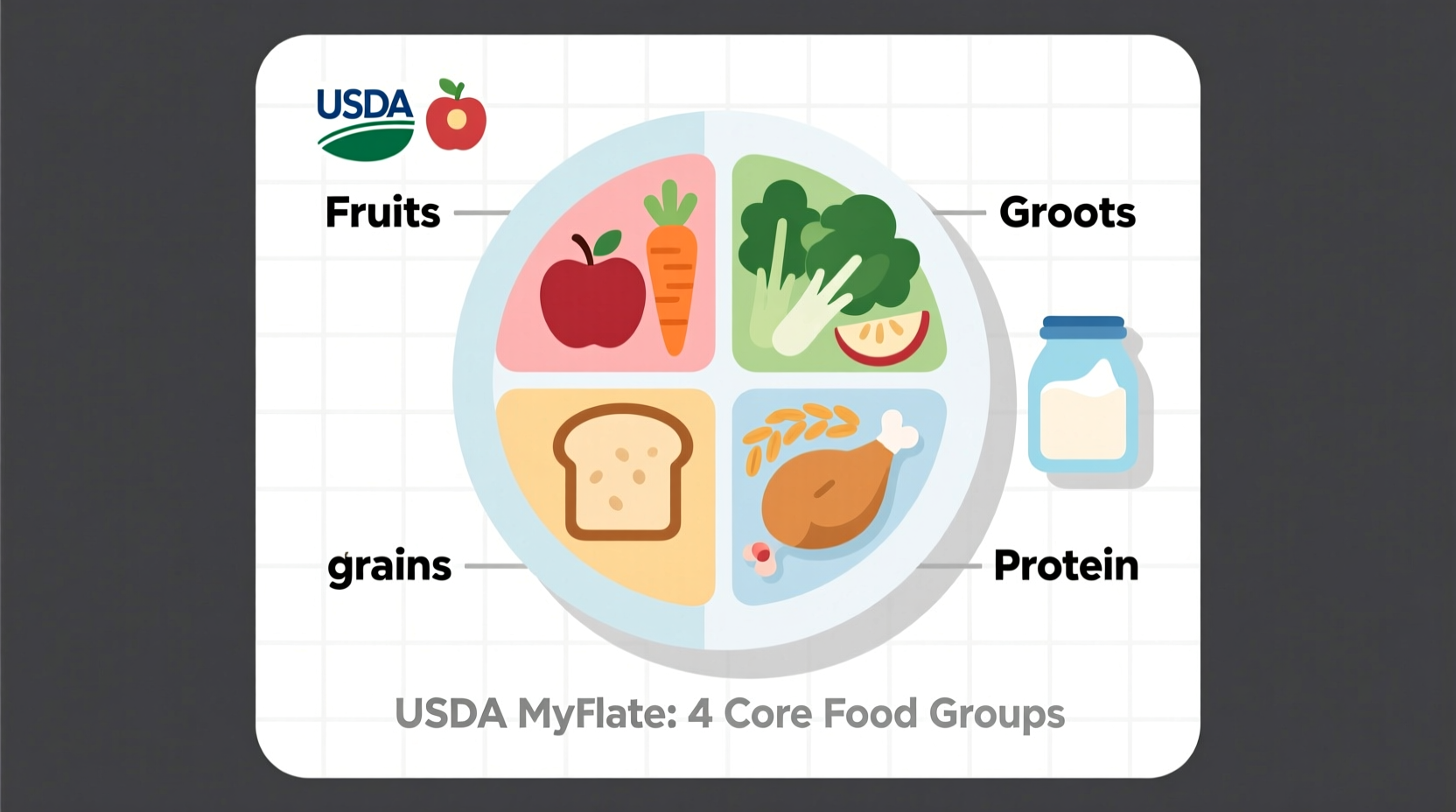Ever wondered how many food groups there really are? You're not alone. Nutrition guidelines vary globally, creating confusion about basic dietary categories. This comprehensive guide cuts through the noise with verified information from leading health authorities worldwide, helping you understand food group systems and apply them to your daily eating habits.
Global Food Group Systems at a Glance
When researching how many food groups are there in standard dietary guidelines, you'll discover significant variation between countries. This isn't arbitrary—each system reflects cultural eating patterns, nutritional research priorities, and public health goals.
| Country/System | Number of Groups | Primary Food Groups | Key Differences |
|---|---|---|---|
| USDA MyPlate (USA) | 5 | Fruits, Vegetables, Grains, Protein, Dairy | Dairy as separate group; protein includes both animal and plant sources |
| Canada's Food Guide | 4 | Vegetables & Fruits, Protein, Whole Grains, Healthy Fats | No separate dairy group; emphasizes plant-based proteins; includes healthy fats category |
| NHS Eatwell Guide (UK) | 5 | Fruit & Vegetables, Carbohydrates, Protein, Dairy, Fats | Carbohydrates as primary group; fats as separate category |
| Australian Guide | 5 | Vegetables, Fruits, Grains, Lean Proteins, Dairy | Strong emphasis on whole grains; dairy includes alternatives |
Evolution of Food Group Classification
The question how many food groups are there historically reveals an interesting timeline of nutritional science development. Food grouping systems have evolved significantly as our understanding of nutrition has advanced:
- 1916: First US food classification with 5 groups (milk/fish, meat, cereals, fruits/vegetables, fats/sugars)
- 1943: Basic Seven introduced during WWII with 7 groups including butter/fortified milk
- 1956: Basic Four simplified to milk, meat, fruits/vegetables, bread/cereal
- 1992: Food Guide Pyramid introduced with 6 groups
- 2011: MyPlate replaced the pyramid with 5 distinct groups
- 2019: Canada eliminated dairy as a separate group in their food guide
This evolution reflects changing scientific understanding—particularly regarding fats, dairy alternatives, and plant-based proteins. As noted by nutrition researchers at Harvard T.H. Chan School of Public Health, "The shift from pyramid to plate models represents not just visual simplification but a fundamental change in how we conceptualize balanced eating."

Why Food Group Numbers Vary Across Countries
When examining how many food groups are there in different national systems, the variation stems from several key factors:
Cultural Dietary Patterns
Countries structure food groups based on traditional eating habits. Japan's food guide includes a distinct group for traditional items like green tea and seaweed, reflecting their cultural significance in Japanese cuisine.
Scientific Interpretation Differences
Nutrition science isn't entirely uniform globally. Some countries prioritize certain nutrients over others based on population health concerns. Scandinavian countries often emphasize fish as a separate category due to its importance in regional diets and omega-3 benefits.
Political and Agricultural Influences
Food industry lobbying has historically influenced food group classifications. The US dairy industry's influence is evident in dairy maintaining its separate category despite growing evidence supporting plant-based alternatives.
Practical Application: Using Food Groups in Daily Life
Understanding how many food groups there are matters less than knowing how to apply this knowledge. Here's how to translate food group information into practical meal planning:
Building Balanced Meals Using Different Systems
Regardless of which system you follow, aim to include multiple food groups in each meal. A balanced plate typically contains:
- ½ plate vegetables and fruits
- ¼ plate protein sources
- ¼ plate grains or starchy vegetables
- Dairy or alternatives served separately
Common Food Group Misclassifications
Many people misunderstand where certain foods belong:
- Potatoes: Classified as vegetables in most systems but function as starches nutritionally
- Beans/Lentils: Count as both protein and vegetable groups in many systems
- Nuts/Seeds: Often placed in protein or healthy fats categories
- Whole Fruit vs. Juice: Whole fruit counts in the fruit group, but juice has different nutritional properties
Special Considerations Across Life Stages
Food group recommendations aren't one-size-fits-all. The number of food groups needed remains consistent, but portion sizes and emphasis change:
- Children: Need smaller portions but same food group diversity; dairy remains important for development
- Older Adults: May need increased protein portions while maintaining other groups
- Pregnant Women: Require increased portions from specific groups, particularly protein and dairy
- Vegans/Vegetarians: Must carefully combine plant proteins to meet requirements across food groups
Emerging Trends in Food Classification
As research advances, nutrition experts are questioning traditional food group models. Current discussions include:
- Should ultra-processed foods be a separate category?
- Do plant-based alternatives warrant their own classification?
- Should water be considered a fundamental food group?
- How to account for functional foods with specific health benefits?
According to a 2023 review in Nutrition Reviews, "The future of dietary guidance may move away from rigid food group counting toward more flexible patterns that emphasize whole foods and processing levels."
Putting It All Together: Your Action Plan
Instead of focusing solely on how many food groups are there, consider these practical steps:
- Identify which food group system aligns with your cultural context and health goals
- Use the plate method for visual portion guidance at each meal
- Track your food group diversity for one week using a simple journal
- Gradually increase your vegetable variety before adjusting other groups
- Consult a registered dietitian for personalized guidance based on your health needs











 浙公网安备
33010002000092号
浙公网安备
33010002000092号 浙B2-20120091-4
浙B2-20120091-4